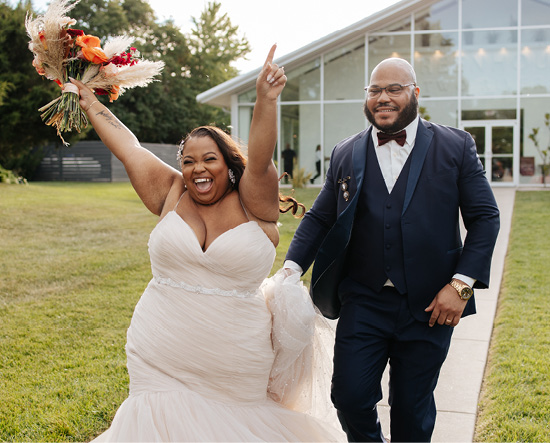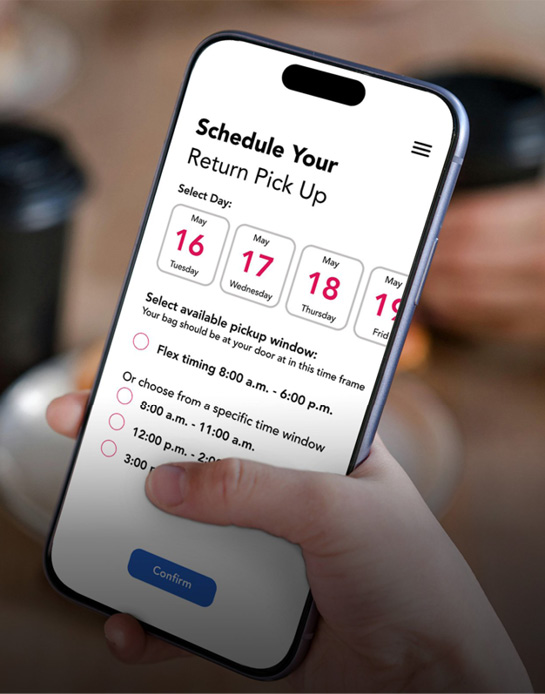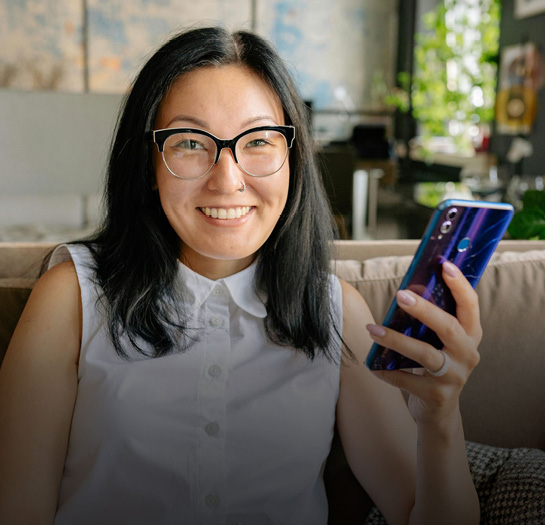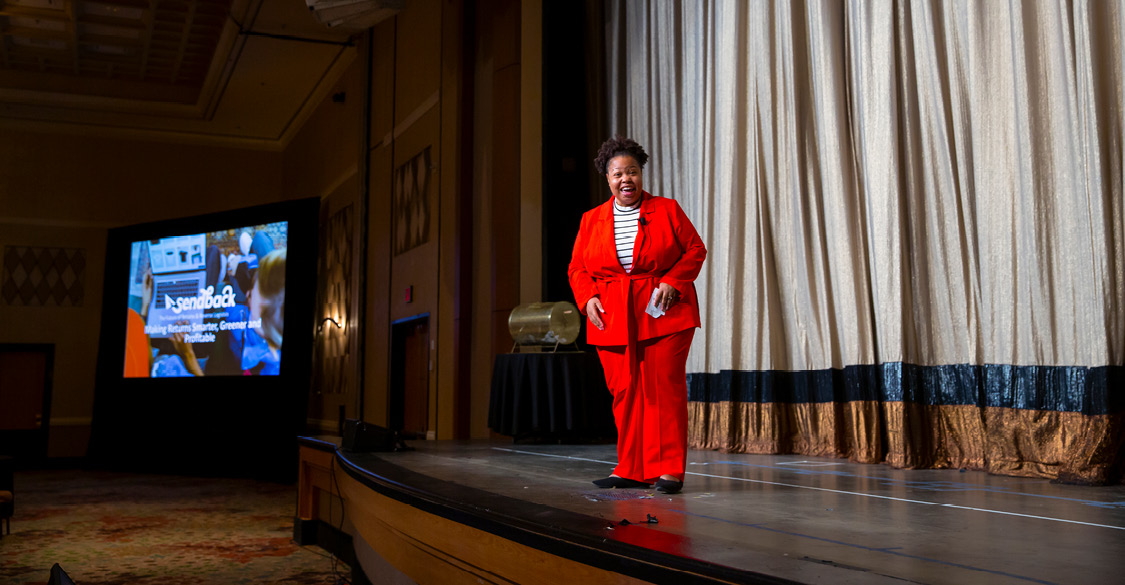A founder’s journey to build a smarter, more sustainable return system centered on the people it left behind.
It all began with two high school sweethearts who decided to get married.
My husband has a background in finance, which meant he was laser-focused on staying within our wedding budget. I, on the other hand, had been dreaming about this day since I was a little girl. Trying to strike a balance between my Pinterest board and our bank account, I decided to become the DIY queen I knew I could be—determined to bring my vision to life on a budget.

Our wedding was beautiful. But when the day was over, what remained was a mountain of unreturned packages. Some of the DIY projects didn’t work out. Others were too complicated—even my financially conscious husband said they weren’t worth the time. Some packages didn’t even arrive in time.
In December, shortly after Christmas, I was sitting on our couch when my husband came downstairs and stared at the pile of boxes. “Are you ever going to return these?” he asked.
I said yes—but the truth was, I didn’t even know if I could. Were the return windows closed? Did I need to repackage them? Print a label? Where would I even take them?
He said, “You need a service that comes to pick them up for you.”
That sparked something. I loved the idea—but assumed it already existed. I looked. I found nothing.
That moment felt like striking gold.
From December 2022 through April 2023, I spent my nights, weekends, and lunch breaks researching what it would take to make that service a reality. What I discovered didn’t shock me—but it confirmed what I had experienced as a plus-size consumer for years.
As someone whose size is often excluded from in-store inventory, online shopping has always been my only option. But with inaccurate size charts, poor product descriptions, and inconsistent retailer policies, I often had no choice but to “bracket”—ordering multiple sizes in hopes that at least one would fit. I didn’t want to do that. It cost more money, took more time, and left me stuck managing returns I didn’t ask for. And I’m not alone.
While retailers have studied the cost of returns to their bottom line, there is very little research on the cost to consumers. The number most often cited—$4.8 billion in lost refunds every year—barely scratches the surface. From the 300+ people I’ve interviewed since starting this journey, I know that number is just the beginning.
The reasons consumers miss return windows vary, but they all point to one thing: the system wasn’t built with them in mind. Some people don’t have access to printers or boxes. Others can’t leave work to stand in line at the post office. Some can’t afford return shipping or restocking fees. Others are caregivers, or parents, or students working two jobs just to make ends meet.
Retailers call this bracketing. And yes, some consumers may take advantage. But many of us are simply trying to ensure we have something that fits for a wedding, a work event, or a family celebration. If given the option to spend less and receive exactly what we needed, most people would choose that.
But that’s not the option we’re given.
And that’s only half the issue. The environmental impact of returns is staggering. Every year, 292.4 million tons of waste end up in landfills—much of it from returned or unsold merchandise. Products that could’ve been resold, donated, or recycled instead get destroyed, burned, or buried.
What started as a personal inconvenience quickly revealed itself as a systemic breakdown. One that affects not only consumers and retailers—but our planet.
Most reverse logistics systems are built for B2B returns or internal retailer efficiency. Very few consider the everyday shopper. Even fewer consider how we create circular systems that reduce waste at the consumer level.
The last mile for returns is broken and fragmented—and I knew there had to be a better way.
Once the idea took root, I knew I couldn’t let it go.
After many long nights of researching, I decided to take a leap of faith and officially registered the business in April 2023. I was still working full-time, still figuring things out, and still in research mode—because the truth was, there was so much I didn’t know yet. I had no background in logistics, tech, or supply chain—but I had curiosity, lived experience, and a strong desire to solve a problem that clearly wasn’t mine alone.
I dove deep. I read everything I could find on reverse logistics. I studied startups, white papers, and case studies. I explored industry trends, scrolled Reddit threads, and joined online communities. And most importantly—I listened.
From the very beginning, I knew that whatever I built had to be centered around the customer—not just efficiency. There are plenty of reverse logistics companies serving retailers. The world didn’t need another one. What was missing was a solution for people—everyday consumers who were being left out of the equation.
At first, I thought I was building an app for busy people who needed help managing online returns. But the deeper I dug, the more I realized what I was designing was far more layered: a logistics system rooted in access, empathy, and circularity.

My upbringing as a scrappy, creative kid informs how I make decisions as an entrepreneur. Eight months after registering SendBack, I pitched for the first time and won a $20,000 non-dilutive grant. After talking to other founders and interviewing several development agencies, I knew I had to approach things differently. I was fully aware of my gaps—and I didn’t want them to be my downfall.
So instead of spending the full $20,000 on building the app, I got resourceful. I signed up for a free self-paced computer science course through Harvard to gain foundational knowledge. I partnered with a student developer through Washington University’s Skandalaris Center to bring the vision to life. Together, we initially created a web-based platform that allowed users to schedule doorstep pickups for returns or donations.
From there, we continued to build. Every conversation I had with potential customers informed the next decision. I wasn’t focused on what I thought was best—I was focused on solving the actual problem. One of the most valuable lessons I’ve learned, especially through my time in the Builders + Backers program, is this: fall in love with the problem, not the solution. Because the solution will change. There are many ways to solve the same problem.
I focused on functionality and feedback rather than speed. Truthfully, if I had launched an app on day one, it wouldn’t have been the solution we have today—and that’s okay. Great things take time.
I didn’t want to replicate what the postal service or gig-based delivery apps were already doing. I wanted to reimagine the experience from the user’s perspective. What would it look like to build a business that truly centers the customer? I believe many businesses start with that goal—but when the pressure for astronomical growth kicks in, focus shifts to the bottom line. Customer needs become an afterthought.
That question became our north star.

In fall 2024, we launched a beta test in partnership with CIC coworking space in St. Louis. The model was simple: customers dropped off their returns in designated areas, and we took care of the rest. No printer. No repackaging. No guesswork.
The response was encouraging—and it validated what I had believed from the start: reverse logistics doesn’t need to be complicated to be effective. It just needs to be built with people in mind.
At SendBack, we’ve always known that returns are more than just a logistics problem—they’re a consumer experience problem, an equity problem, and increasingly, a planetary one.
That’s why we’re not just focused on returns. We’re reimagining what reverse logistics could look like if it truly centered the people it claims to serve.
Our model is B2B2C by design—we partner with densely populated communities to provide return and donation services directly where people live. It’s hyper-local, efficient, and cost-effective. But more than that, it’s built to meet people where they are—literally.
We also introduced our Give Back Bag program to make it easy for customers to donate gently used items they no longer need. For far too long, returns and donations have lived in separate silos. We believe they’re part of the same cycle—and when we treat them as such, we can reduce waste and increase access at the same time.
We have some pretty exciting plans in the works to scale our services even further and reach more people. But no matter how we evolve, one thing remains constant: our belief that reverse logistics should be sustainable, accessible, and customer-first.
When I first received the news that I was one of the startups selected to pitch at the Reverse Logistics Association (RLA) conference this year, I was head over heels—and admittedly, a little scared. I had pitched all over the country, but this pitch felt different. This time, I’d be speaking in front of my peers—people who had been in the industry far longer than I had, with decades of expertise and insight.
But what I quickly realized was that everyone I encountered offered a helping hand, a word of advice, and encouragement. My heart was so full. So many people wanted to talk with me, to learn more, to cheer me on. They truly believed in me—and in what I’m building.
I am eternally grateful for the support of the RLA and all the members I met. To have been chosen as the People’s Choice winner is something I do not take lightly. Industry professionals, from different disciplines, with different lived experiences, said yes—I back her, I’m with her, I believe in her. And sometimes in life, all you need is for people to believe in the beautiful, bold vision that God gave you.
I walk into rooms with my head held high—not only because I say I belong there, but because I’ve shown up, scared and all, bet on myself, and been met with a resounding yes from my industry.
I’m not just building SendBack for me. I’m building it for everyone who’s ever been overlooked, underserved by systems that weren’t designed with them in mind, and for anyone who deserves the same opportunities as those with access to mobility, neurotypical systems, financial resources, or transportation.
This movement is for you. Because you deserve companies built to serve you.

As I look ahead, I’m hopeful.
- Hopeful that more founders will be bold enough to design with empathy.
- Hopeful that retailers will begin to see returns not as a liability—but as an opportunity for brand trust and retention, and to work with startups who are daring to innovate. Because what has worked won’t get us to where we need to go.
- Hopeful that, as an industry, we’ll build systems that protect both people and the planet.
Reverse logistics is ready for a revolution—one that’s collaborative, community-minded, and built to last.
If you're reading this and feel the pull to reimagine what’s possible—I invite you to join us.
We’re not just building better returns.
We’re building a better way forward.
Shaniqua Jones-Williams is the Founder and CEO at SendBack, a reverse logistics company reimagining returns with sustainability, accessibility, and community at the core. A proud St. Louis native, she brings a background in nonprofit development, marketing, and entrepreneurship to her work. Shaniqua is a passionate advocate for equity in all spaces and she is bringing her passion to logistics. She believes companies should be built with people in mind—especially those often overlooked.